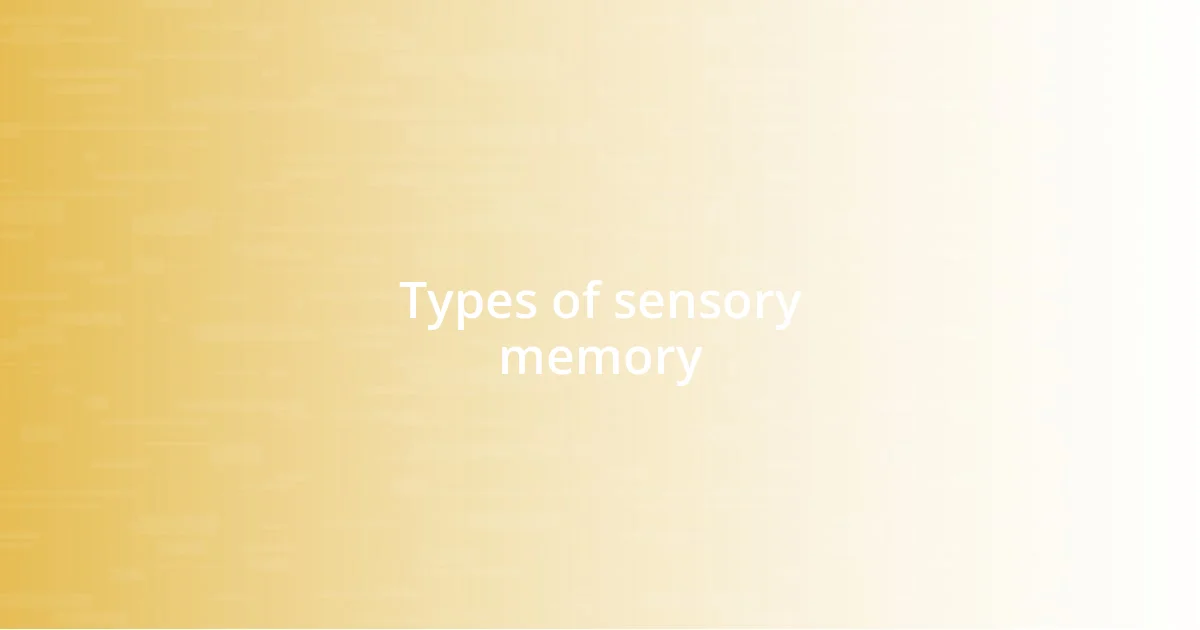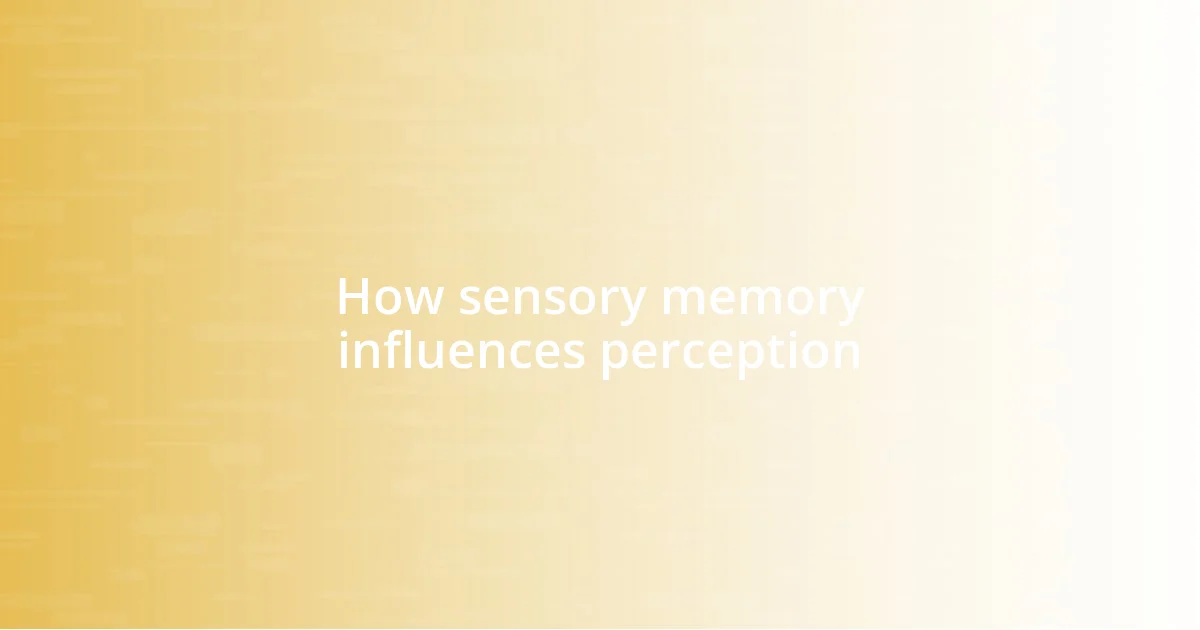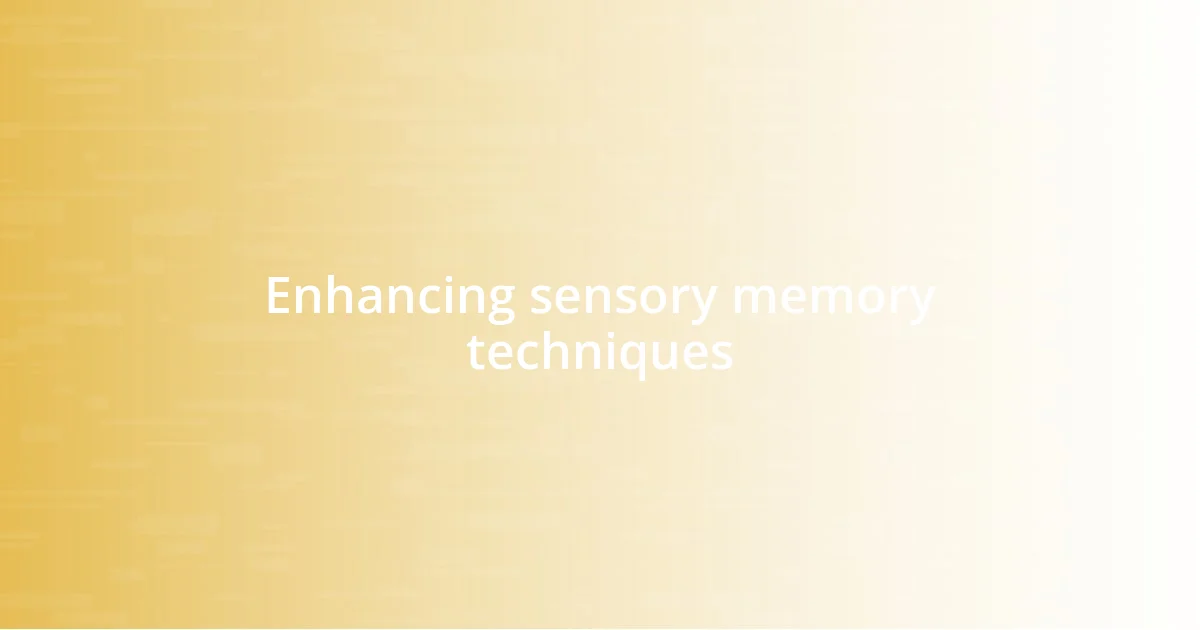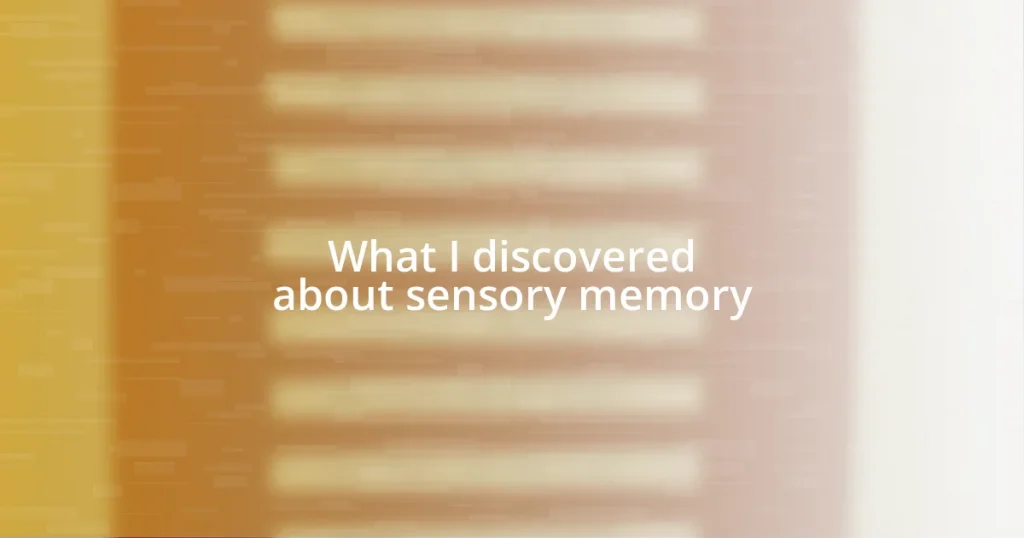Key takeaways:
- Sensory memory serves as our initial interaction with the world, processing sensory information almost instantaneously, including iconic (visual), echoic (auditory), tactile (touch), olfactory (smell), and gustatory (taste) memories.
- Active engagement of our senses, such as creating sensory snapshots or journaling experiences, can enhance the retention of sensory memories and deepen emotional connections to those moments.
- Common misconceptions include the belief that sensory memory lasts longer than it actually does and that it operates independently; in reality, it is fleeting and interwoven with short-term and long-term memory processes, significantly influencing our emotional experiences.

Understanding sensory memory basics
Sensory memory is fascinating because it serves as our initial interaction with the world. It processes information from our senses—sight, sound, touch, taste, and smell—almost instantaneously. Have you ever caught a whiff of a favorite dish cooking and felt warmth flood your memories? That’s sensory memory at work, holding those fleeting impressions for just a moment before deciding what to keep.
Visual sensory memory, known as iconic memory, is particularly intriguing. I once attended a photography exhibit and was struck by a vibrant photo that lingered in my mind. The way it captured a moment reminded me of how our brains can briefly hold visual details, like a snapshot that fades as quickly as it appears. Isn’t it incredible how those split seconds can shape our perceptions and experience?
On the other hand, auditory sensory memory, or echoic memory, allows sounds to echo in our brains for a short duration—think about the last time you had a catchy song stuck in your head. I remember humming a tune long after hearing it, illustrating how my mind held onto that auditory experience. This temporary storage of sensory information is vital for making sense of the complexity around us.

Types of sensory memory
When exploring the types of sensory memory, I find it fascinating how our brains categorize these fleeting experiences. Aside from iconic and echoic memory, tactile memory also plays a role, capturing sensations of touch. I vividly remember running my fingers over a rough tree bark one sunny afternoon. That texture lingered with me for a moment, almost as if it wanted to tell a story. Such memories remind us how sensation can become a doorway to our past experiences.
- Iconic Memory: This visual sensory memory allows us to briefly hold onto images. It’s why we can recall a stunning view for a brief second after looking away.
- Echoic Memory: The auditory counterpart, echoic memory enables us to remember sounds, like a friend’s laughter or a favorite song’s melody, for a few moments.
- Tactile Memory: Engaging our sense of touch, this memory allows us to retain impressions of textures, temperatures, or even weight—like remembering how it felt to hold a warm cup of coffee.
- Olfactory Memory: Our sense of smell is incredibly powerful. I still feel transported to my grandmother’s kitchen when I catch a hint of vanilla or cinnamon in the air; those scents bring vivid memories rushing back.
- Gustatory Memory: Taste memory involves recalling flavors. I remember biting into a juicy peach and still being able to savor that sweetness long after—I can almost feel the sun on my skin when I think about it!

How sensory memory influences perception
Sensory memory paints our perceptions in vivid colors, often without us even realizing it. For instance, the moment I step into a bakery, the sweet aroma of freshly baked bread instantly envelops me, evoking a sense of comfort and nostalgia. This fleeting sensory memory not only shapes my immediate emotions but also influences how I perceive the entire experience, associating that smell with warmth and home. It’s remarkable how such transient impressions can create deep emotional connections.
Moreover, I once had an experience at a concert where the vibrant sounds and flickering lights created a memorable atmosphere. Long after the show ended, I could still hear the echoes of the music in my mind. This phenomenon highlights the role of auditory sensory memory—not only does it help me recall the melody, but it also enriches my perception of the event as a whole, filling it with emotion long after the last note fades away. Isn’t it intriguing how those brief memories magnify our experiences?
On another occasion, while watching a movie, a scene filled with vibrant colors captured my attention. I realized how visual sensory memory allowed me to soak in stunning details, such as the way sunlight danced on the water. That vivid imagery lingered, enhancing my overall perception of beauty and emotion in the story. I find it fascinating that these instantaneous moments serve as the canvas upon which our perceptions are painted, providing depth to every experience we encounter.
| Type of Sensory Memory | Influence on Perception |
|---|---|
| Iconic Memory | Enhances visual experiences, allowing for brief retention of images that shape overall perception |
| Echoic Memory | Provides a lasting echo of sounds that enhances emotional engagement and recollection of experiences |
| Tactile Memory | Holds onto sensations that create a connection with the physical world, influencing our perception of touch |
| Olfactory Memory | Evokes strong emotional responses, often linking smells to past experiences and enhancing the context of the present moment |
| Gustatory Memory | Creates enduring impressions of flavors that can influence mood and enhance the dining experience |

Enhancing sensory memory techniques
To enhance sensory memory, I’ve found that actively engaging my senses can make a huge difference. For instance, when I walk through a park, I take a moment to close my eyes and focus on the sounds around me—like the rustle of leaves or distant laughter. This practice not only deepens my connection to the environment but also helps those auditory memories linger longer in my mind. Have you ever tried to listen closely when surrounded by nature?
One technique I enjoy is creating sensory snapshots. When I taste something delicious—like a perfectly ripe strawberry—I pause to appreciate its vibrant color and aroma before taking a bite. It’s a small ritual, but it allows me to imprint that moment in my memory, making it more vivid and recallable down the road. Remembering those sweet flavors can transport me back to sunny days spent in a garden. Isn’t it remarkable how such simple actions can sharpen our sensory experiences?
Another method is to journal my sensory experiences. After a day filled with new sensations, I take a few moments to write about them. When I reflect on how certain aromas or textures made me feel, it reinforces those memories more firmly. I can recall an exciting evening at a bustling market, where the mixture of spices and the cheerful chatter of vendors created such an immersive environment. By documenting those moments, I ensure they stay with me longer. What could be more rewarding than capturing fleeting experiences in words?

Common misconceptions about sensory memory
It’s interesting how many people think sensory memory lasts longer than it actually does. I used to believe that once I registered a sensory experience, it would stick with me indefinitely. However, I’ve learned that sensory memories are incredibly fleeting, often lasting just a few seconds. For instance, after leaving a vibrant art gallery, I can recall the colors I saw, but if I don’t capture that impression quickly, it fades almost instantly. Have you ever tried to recall a smell from a week ago? It’s quite challenging, isn’t it?
Another misconception I’ve encountered is the idea that sensory memory operates independently of other types of memory. In reality, sensory memory serves as just the first step in a much larger process. From my experience, the smells, sounds, and sights I encounter don’t exist in isolation; they weave into my short-term and long-term memories. Think about it: when I walk into a café and catch a whiff of coffee, that sensory memory does more than just register—it can trigger a flood of related memories, like the time I sat in a similar café with a good friend. That’s the beauty of our memory systems working in harmony.
Some people also tend to underestimate the power of sensory memory to evoke emotions. I remember the first time I heard a particular song that brought back memories of a cozy winter evening spent with family. It was stunning how quickly emotions rushed in, reminding me of joy and love. Sensory memory is like a time capsule for our feelings, capturing those moments that resonate deeply with us. Have you ever found yourself taken aback by a scent or sound that instantly transports you back in time? That’s the magic of sensory memory—it’s not just about recalling experiences, but also about reliving the emotions tied to them.















